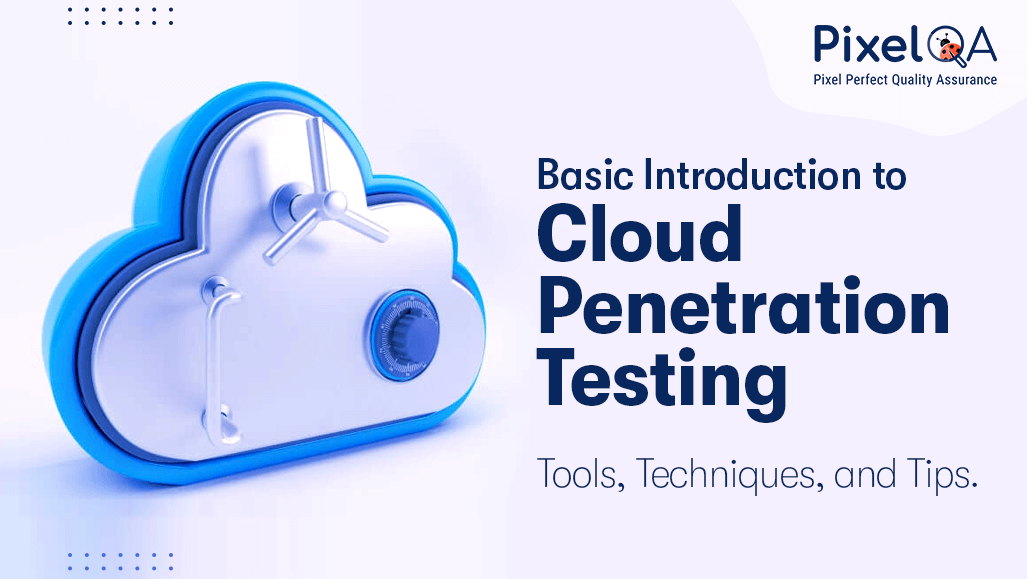
In current times, businesses are moving quickly to the cloud because of its respect, adaptability, and flexibility. These advantages do, however, come with contemporary security challenges. One of the best ways to ensure that your cloud-based systems are secure is to conduct Penetration Testing Services.
We shall define penetration testing for the cloud. What makes it significant? The most popular resources and practical advice to help you get started on this blog. The information you need to begin cloud penetration testing is provided in this post. Regardless of your level of expertise in cyber security or your desire to learn more.
Table of Contents
- What is Cloud Penetration Testing?
- Why Is Cloud Penetration Testing Important?
- Common Tools Used in Cloud Penetration Testing
- Cloud Penetration Testing Techniques
- Tips for Cloud Penetration Testing
- Conclusion
What is Cloud Penetration Testing?
Ethical hacking is another term for cloud penetration testing. It is a simulated cyberattack on a cloud-based infrastructure that looks for vulnerabilities that threat hackers have recently exploited and evaluates security penetration testing to compromise the system in a certain way. Regulated and examined in the case of the cloud This involves inspecting cloud services, apps, and infrastructure for weaknesses.
Compared to conventional IT infrastructure There are difficulties with the cloud. This is because it relies on third-party cost models and is distributed. These variations need specialized knowledge of cloud security and methods for conducting penetration tests.
Why Is Cloud Penetration Testing Important?
Situations in the cloud are always changing. Additionally, in these circumstances, businesses retain critical information. Send out the application and provide an overview of the administration. The use of entrance testing to guarantee the security of a company's data and systems is growing. The significance of cloud penetration testing is made clear by the increasing complexity of attacks.
- Proactive Security: Penetration testing detects flaws before hackers do, allowing you to patch them.
- Compliance: Many industries are subject to regulatory frameworks (such as HIPAA, PCI-DSS, and GDPR), which frequently require periodic security audits to guarantee compliance.
- Risk Management: It enables enterprises to better understand the security threats they face and how to mitigate them.
- Improved Trust: Regular testing promotes confidence in consumers and stakeholders, demonstrating that security is a top priority.
Key Steps in Cloud Penetration Testing
Cloud penetration testing is a methodical process that is frequently separated into multiple stages. Here is a summary of the essential steps:
1. Reconnaissance (Information Gathering)
Pen-testers attempt to gather as much intelligence on the target cloud environment prior to attempting to find vulnerabilities. The aim of this step involves mapping out the system and identifying exposed services. Information is collected pertaining to IP addresses, cloud services in use, network configurations, and publicly accessible assets.
Reconnaissance tools that would be familiarized with are the Harvester, Shodan, and Nmap. For instance, Nmap finds open ports and Shodan finds various Internet-enabled devices.
2. Vulnerability Scanning
The next step actually is known vulnerability finding after conducting a thorough investigation. Vulnerability scanners can find detection of vulnerabilities, such as outdated software, dry ports that could be exploited, or wrong permissions.
Popular tools for vulnerability scanning include:
- Nessus
- OpenVAS
- Qualys
These techniques are excellent for immediately identifying system problems that must be changed.
3. Exploitation
Exploiting vulnerabilities comes next. This stage simulates the actions an actual attacker might take to obtain unauthorized access. To show how an attacker could compromise the system, this is done safely and morally in a penetration testing scenario.
Exploitation techniques may involve:
- Privilege escalation: Trying to gain higher levels of access, such as administrator privileges.
- Injection attacks: Exploiting SQL or command injection flaws.
- Password cracking: Attempting to crack weak passwords using tools like John the Ripper or Hydra.
4. Post-Exploitation
During this stage, testers investigate their capabilities after gaining access to the system. They might attempt data extraction, environment access, or network pivots. The goal is to assess the full impact of the vulnerability.
Post-exploitation tools include:
- Metasploit
- Empire
- Cobalt Strike
5. Reporting
Ultimately, a comprehensive report is produced that includes all findings, vulnerabilities that have been exploited, and suggestions for enhancing security. The report should contain remediation action items and be easily comprehensible.
Common Tools Used in Cloud Penetration Testing
A range of tools are used by ethical hackers to do a cloud penetration test. The following are a few that you should be aware of:
1. Burp Suite
Burp Suite has become popular among hackers to assess the security of web applications and host online applications. It is crucial to find exploitable vulnerabilities such as SQL injection or XSS, as well as compromised authorizations. It is particularly useful for security assessments on applications and APIs hosted in the cloud.
2. OWASP ZAP
OWASP Destroy (Destroy) is an open-source program aimed at discovering web application vulnerabilities. It serves as an excellent alternate option for Burp Suite and is instrumental in scanning cloud-hosted web applications for common security vulnerabilities.
3. Nmap
Nmap is a heterogeneous tool used mainly for cloud penetration testing. It helps in determining open ports, services running on them, and other structured data that may be vulnerable.
4. Metasploit
A powerful framework for writing and running malicious code is Metasploit. It can be applied to automated penetration testing in cloud environments and is ideal for assessing known vulnerabilities. It has known flaws and can be used for automated penetration testing in cloud environments.
5. AWS CloudPen
Penetration testers typically utilize CloudPen and other AWS-focused penetration testing tools to manipulate their target's administration and settings. It is paramount to assess AWS security concerning the massive number of organizations that have adopted AWS for their cloud infrastructure.
Cloud Penetration Testing Techniques
It's too simplistic to understand some of the primary tactics used in a cloud penetration test, even though the mentioned advancements are essential. Here are some things to consider:
1. Misconfiguration Exploitation
Cloud scenarios are frequently misconfigured because of human mistakes or complexity. For example, a poorly configured Identity and Access Management (IAM) component may provide attackers more access than they should. Additionally, improperly configured capacity buckets may be exposed.
One important technique in cloud penetration testing is to take advantage of these configuration errors. To identify these problems, analysts regularly examine IAM components, security groups, and capacity settings.
2. API Testing
APIs are essential for communication in many cloud administrations. Vulnerabilities in these APIs could include information leaks, incorrect confirmation, or missing access controls. API testing tools are used by ethical programmers to identify and exploit these vulnerabilities.
3. Cloud-Specific Attacks
There are several service offerings made available by cloud providers, which include serverless computing and containerization, and each has its attendant risk. Penetration testers tend to focus on these specialized services, investigating vulnerabilities within serverless functions, containers, or cloud storage services.
4. Privilege Escalation
A prevalent attack vector in cloud scenarios is benefit enhancement. Attackers might cause havoc if they can elevate their advantages from basic client to administrator level. To find any solutions to increase security in the cloud environment, penetration testers replicate this behavior.
Tips for Cloud Penetration Testing
For beginners, cloud penetration testing can seem like an overwhelming task. Here are some tips to help you get started:
1. Start Small: Start with smaller cloud platforms such as Microsoft Azure, Google Cloud, or AWS. Spend some time trying out sophisticated exams and familiarize yourself with their administration and security settings.
2. Use Cloud Penetration Testing Labs: Practice in a supervised setting. Cloud penetration testing labs that replicate real-world situations are provided by platforms such as Hack the Box and TryHackMe.
3. Understand the Cloud Provider’s Terms: AWS and many other cloud providers have some limitations regarding penetration testing. Therefore, treaties binding for use should be well reviewed and obtained before commencing tests to keep a safe distance from unwanted deals.
4. Stay Up to Date: Keeping up with unused devices or protocols is another area that most people tend to overlook, and still another area is to keep up with vulnerabilities. The security industry changes so things can get out of hand. Keep following the news, blogs, and cybersecurity resources.
5. Get Certified:Certification such as Certified Ethical Hacker (CEH) or the AWS Certified Security Specialty may be worth the investment if you are seriously considering cloud penetration testing. These certifications would boost your knowledge in the industry as well as give more credibility to you.
Conclusion
Cloud penetration testing is one of the most crucial components of protecting cloud apps and frameworks. By becoming acquainted with the instruments, methods, and directions offered in this manual, or by partnering with a trusted software testing company, you can start your path to penetration by testing the cloud. Do not forget to act morally. Keep yourself updated and practice frequently to enhance your abilities.
About Author

Rushi Mistry is a Security Tester at PixelQA with a focus on cybersecurity. He is passionate about IoT penetration testing and is working towards obtaining a CISSP certification, with the ultimate goal of becoming a Chief Information Security Officer (CISO).

 (1)_638713959821482403.png)